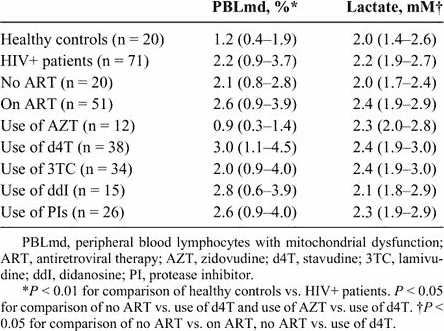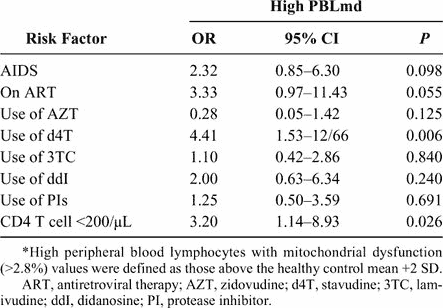| |
HCV Infections in Newly Freed Inmates Are a Rising Concern
|
| |
| |
Factors Associated With Mitochondrial Dysfunction in Circulating Peripheral Blood Lymphocytes From HIV-Infected People
JAIDS Journal of Acquired Immune Deficiency Syndromes 2003; 34(1):32-36
*Rosa Polo; Susana Martinez; Pilar Madrigal; Miguel Gonzalez-Muñoz From the Departments of Immunology and *Infectious Disease, Hospital Carlos III, Madrid, Spain
Abstract: Nucleoside analogue reverse transcriptase inhibitor (NRTI)-associated mitochondrial toxicity is an important issue in the clinical management of HIV infection. The aim of this study was the detection of mitochondrial dysfunction by flow cytometry in lymphocytes from HIV-infected individuals and its association with blood lactate levels, clinical and virologic status, and the different NRTI-based therapies.
Lower peripheral blood lymphocytes with mitochondrial dysfunction (PBLmd) percentages were observed in healthy controls (1.2, interquartile range [IQR] = 0.4-1.9) than in patients (2.2, IQR = 0.9-3.7; P < 0.01). Stavudine-containing therapy showed higher PBLmd percentages (3.0, IQR =1.1-4.5) than no treatment (2.1, IQR = 0.8-2.8; P < 0.05) or zidovudine-based therapy (0.9, IQR = 0.3-1.4; P <0.01).
A significant inverse correlation was found between PBLmd and CD4 T-cell percentage and absolute count. Patients with an AIDS diagnosis had higher PBLmd percentage (2.7, IQR = 1.1-4.4) than HIV-positive non-AIDS patients (1.4, IQR = 0.6-3.0; P = 0.012).
In multivariate analysis, use of stavudine (odds ratio [OR] = 5.86, 95% CI = 1.81-19.01, P = 0.003) and CD4 T-cell counts <200/[mu]L (OR = 4.51, 95% CI = 1.38-14.70, P = 0.012) were independent predictors of high PBLmd percentage. This cross-sectional study shows that antiretroviral drugs can impair the in vivo mitochondrial function of PBLs.
RESULTS
PBLmd and blood lactate values in healthy controls, untreated and treated HIV-infected patients, use of different NRTIs, and use of PIs are shown in Table 2. Use of PIs was considered in the analyses because PIs may inhibit [Delta][psi] decrease. The following comparisons in PBLmd and lactate values were performed: healthy controls versus HIV-infected patients, untreated group versus use of AZT, d4T, 3TC, ddI, or PIs, use of AZT versus use of d4T, and use of 3TC versus use of ddI. TABLE 2. Differences in Peripheral Blood Lymphocytes With Mitochondrial Dysfunction and Blood Lactate Values Between Healthy Controls, Patients, Use of Nucleoside Reverse Transcriptase Inhibitors, and Use of Protease Inhibitors
|
| |
| |
 |
|
| |
| |
Significantly higher PBLmd percentages were found in patients than in healthy controls. Among NRTIs used in our study population, d4T-based therapy showed higher PBLmd percentages than the untreated group and the AZT-based therapy. Significantly lower blood lactate levels were found in untreated patients than in patients treated with antiretroviral therapy or d4T-based therapy.
Correlation analysis showed significant inverse correlations between PBLmd and CD4 T-cell percentage (r = -0.28, P= 0.02) and absolute count (r = -0.30, P = 0.01), but PBLmd did not correlate with age, duration of HIV infection, duration of current antiretroviral therapy, duration of d4T therapy, CD8 T-cell number, lactate levels, or plasma HIV RNA. No difference was found in PBLmd percentage between patients with undetectable (<1.7 log10 copies/mL; n =30) and detectable (n = 41) viral load (1.3 [0.8-3.7] and 2.7 [1.0-3.7], respectively; P = 0.10).
To study whether advanced disease was associated with PBLmd, the PBLmds were compared in HIV-positive patients with (n = 39) and without (n = 32) AIDS . Patients with AIDS showed a higher percentage (2.7, IQR = 1.1-4.4) than HIV-positive patients without AIDS (1.4, IQR = 0.6-3.0; P = 0.012). In addition, patients with AIDS showed lower CD4 T-cell counts (157, IQR = 69-384) than those without (480, IQR = 275-745; P < 0.001). No differences in PBLmd between AIDS patients with and without active opportunistic diseases were found (P = 0.34).
High PBLmd percentages were defined as those above the healthy control mean +2 SD (2.8%).. HIV-infected patients with high PBLmds had significantly lower CD4 T-cell counts. Comparison of duration of d4T therapy between patients with high and low PBLmds showed no significant difference. Risk factors associated with high PBLmd were evaluated through univariate logistic regression (Table 4). Variables tested were AIDS, on antiretroviral therapy, use of AZT, d4T, 3TC, ddI, or PI, and CD4 T-cell count < 200/[mu]L. Analysis showed that use of d4T (OR = 4.41, P = 0.006) and CD4 T-cell count <200/[mu]L (OR = 3.20, P = 0.026) were associated with high PBLmd percentage. In multivariate analysis, use of d4T (OR = 5.86, P = 0.003) and CD4 T-cell count < 200/[mu]L (OR = 4.51, P = 0.012) were independent predictors of high PBLmd percentage (Table 5). No independent effect was observed in the use of ddI or 3TC after adjusting for the use of d4T.
Similar analysis was performed for high blood lactate levels defined as those above the healthy control mean +2 SD, that is, 2.7 mM. All untreated patients showed lactate levels <2.7 mM. No significant risk factor was found by univariate analysis, and no model was determined in the multivariate logistic regression analysis for high blood lactate levels, suggesting that high lactate is independent of the type of NRTI used in our study population.
Table 4. Univariate Analysis
|
| |
| |
 |
|
| |
| |
DISCUSSION
Mitochondrial toxicity associated with NRTI use represents a growing important issue in the clinical management of HIV-infected patients in the recent years. The need to identify and monitor mitochondrial toxicity via laboratory markers has led to the development of assays for measurement of mitochondrial DNA depletion. Another laboratory approach to identify NRTI-associated mitochondrial toxicity is based on the measurement of decreased [Delta][psi] as a marker of mitochondrial dysfuntion. Previous reports have reported significant [Delta][psi] decrease in lymphocytes from acutely HIV-infected patients and from untreated and AZT-treated patients. A recent report described an in vitro assay that predicts NRTI mitochondrial toxicity by detecting changes in [Delta][psi] using flow cytometry. The authors showed [Delta][psi] changes using JC-1 and flow cytometry in pancreatic and hepatic human cells induced by hydroxyurea and ddI. Our data indicate that this method can be applied to the study of ex vivo mitochondrial dysfunction in HIV infection. We have observed that PBLmd percentage is higher in HIV-infected patients than in controls and is higher in AIDS than in non-AIDS patients and is inversely correlated with CD4 T-cell number. However, we have found considerably lower PBLmd percentages than those previously reported, probably due to differences in sensitivity and specificity of the probes used for the detection of [Delta][psi] changes.
Taking into account that CD4 T-cell count <200/[mu]L is an independent risk factor for mitochondrial dysfunction and that patients with AIDS showed significantly lower CD4 T-cell counts, this finding suggests that mitochondrial alterations may be involved in the immune suppression in advanced HIV infection. Although we did not find any association between viral load and PBLmd, HIV-1 viral load could play a role in the [Delta][psi] decrease via increased cytokine production or binding of viral proteins to their cellular receptors.
Patients receiving antiretroviral therapy showed significant higher PBLmd percentages than untreated patients. Among the antiretroviral drugs, the use of d4T is independently associated with high PBLmd percentages. Differences between NRTIs could be explained by their different potencies for inducing mitochondrial dysfunction and their ability to alter mitochondrial components other than polymerase [gamma].
NRTI-induced mitochondrial toxicity is thought to cause the treatment-associated hyperlactatemia in HIV-infected patients. Within the spectrum of clinical manifestation appreciated in the NRTI-induced hyperlactatemia,3 our treated patients fell into mild, asymptomatic hyperlactatemia range. The finding of higher blood lactate levels in the use of d4T compared with untreated patients is in agreement with previously published reports. Despite the relationship between mitochondrial dysfunction and increased lactate production, we did not find any association between PBLmd percentages and blood lactate. This could be because blood lactate reflects the balance between the systemic production and clearance of lactate, while our data on mitochondrial dysfunction are peripheral lymphocyte specific. It is important to note that our patients showed compensated hyperlactatemia, and no data can be shown on PBLmd and lactic acidosis. On the other hand, it remains to be determined whether successive detection of high PBLmd percentage in longitudinal studies could be associated with a greater risk for symptomatic hyperlactatemia.
To sum up, the study of mitochondrial dysfunction by flow cytometry can be a useful method to detect NRTI-induced toxicity in HIV-infected patients, and other studies are required to assess its clinical relevance.
|
| |
|
|
|